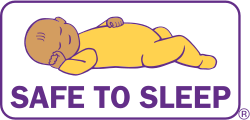SIDS
| Sudden infant death syndrome | |
|---|---|

| |
| Synonyms |
|
| Pronounce | N/A |
| Field | |
| Symptoms | N/A |
| Complications | N/A |
| Onset | One to four months in age |
| Duration | N/A |
| Types | N/A |
| Causes | Unknown |
| Risks |
|
| Diagnosis |
|
| Differential diagnosis |
|
| Prevention |
|
| Treatment | N/A |
| Medication | N/A |
| Prognosis | N/A |
| Frequency | 1 in 1,000–10,000 |
| Deaths | N/A |
Sudden infant death syndrome (SIDS), sometimes referred to as "crib death" or "cot death," is the unexplained death of a seemingly healthy infant, usually during sleep. SIDS typically occurs in children less than one year of age and is one of the leading causes of death in infants worldwide.
Epidemiology
SIDS affects infants predominantly between 1 and 4 months of age, with a peak incidence at 2-3 months. It is more common in males than females. Globally, the incidence of SIDS has declined in recent decades due to public health campaigns promoting safe sleep practices.
Etiology and Risk Factors
The exact cause of SIDS remains unknown, but it is believed to result from a combination of factors, including:
Intrinsic Factors
- Genetics: Some studies suggest a genetic predisposition may contribute to the risk of SIDS.
- Prematurity: Infants born prematurely or with low birth weight are at higher risk.
Extrinsic Factors
- Sleep Environment: Risk increases with unsafe sleep practices such as:
* Prone or side sleeping. * Soft bedding or use of loose blankets. * Overheating during sleep.
- Maternal smoking: Exposure to cigarette smoke during pregnancy or postnatally.
- Co-sleeping: Sharing a bed with parents or siblings can increase the risk of accidental suffocation.
Pathophysiology
The "triple-risk model" is widely accepted as a framework for understanding SIDS. It proposes that SIDS occurs when three conditions overlap: 1. A vulnerable infant with underlying biological predispositions (e.g., immature cardiorespiratory control). 2. A critical developmental period in the infant's life. 3. Exposure to external stressors, such as an unsafe sleep environment.
Prevention
Public health interventions have significantly reduced SIDS rates by promoting safe sleep practices. Key recommendations include:
Safe Sleep Environment
- Place infants on their back to sleep for every nap and nighttime sleep.
- Use a firm sleep surface, such as a mattress in a safety-approved crib.
- Keep soft objects, toys, and loose bedding out of the infant's sleep area.
Additional Guidelines
- Share a room, but not a bed, with the infant.
- Avoid overheating and head covering during sleep.
- Encourage breastfeeding, which is associated with a reduced risk of SIDS.
- Offer a pacifier at naptime and bedtime, but do not force its use.
- Ensure a smoke-free environment during pregnancy and after birth.
Diagnosis
SIDS is a diagnosis of exclusion, made only after a thorough investigation that includes:
- Autopsy: To rule out other causes of death.
- Review of the clinical history.
- Examination of the death scene.
Differential Diagnosis
Conditions that may mimic SIDS and should be considered include:
- Accidental suffocation
- Infections (e.g., sepsis, meningitis)
- Congenital heart defects
- Metabolic disorders
Impact on Families
The sudden and unexpected nature of SIDS is devastating for families. Bereavement support is crucial and may include:
- Counseling services.
- Support groups for grieving parents.
Research and Future Directions
Ongoing research aims to identify biomarkers for SIDS, improve understanding of its pathophysiology, and develop strategies for prevention. Areas of interest include:
- Genomic studies
- Advances in sleep monitoring technology
- Public health policy evaluations
See Also
Transform your life with W8MD's budget GLP-1 injections from $125.
W8MD offers a medical weight loss program to lose weight in Philadelphia. Our physician-supervised medical weight loss provides:
- Most insurances accepted or discounted self-pay rates. We will obtain insurance prior authorizations if needed.
- Generic GLP1 weight loss injections from $125 for the starting dose.
- Also offer prescription weight loss medications including Phentermine, Qsymia, Diethylpropion, Contrave etc.
NYC weight loss doctor appointments
Start your NYC weight loss journey today at our NYC medical weight loss and Philadelphia medical weight loss clinics.
- Call 718-946-5500 to lose weight in NYC or for medical weight loss in Philadelphia 215-676-2334.
- Tags:NYC medical weight loss, Philadelphia lose weight Zepbound NYC, Budget GLP1 weight loss injections, Wegovy Philadelphia, Wegovy NYC, Philadelphia medical weight loss, Brookly weight loss and Wegovy NYC
|
WikiMD's Wellness Encyclopedia |
| Let Food Be Thy Medicine Medicine Thy Food - Hippocrates |
Medical Disclaimer: WikiMD is not a substitute for professional medical advice. The information on WikiMD is provided as an information resource only, may be incorrect, outdated or misleading, and is not to be used or relied on for any diagnostic or treatment purposes. Please consult your health care provider before making any healthcare decisions or for guidance about a specific medical condition. WikiMD expressly disclaims responsibility, and shall have no liability, for any damages, loss, injury, or liability whatsoever suffered as a result of your reliance on the information contained in this site. By visiting this site you agree to the foregoing terms and conditions, which may from time to time be changed or supplemented by WikiMD. If you do not agree to the foregoing terms and conditions, you should not enter or use this site. See full disclaimer.
Credits:Most images are courtesy of Wikimedia commons, and templates, categories Wikipedia, licensed under CC BY SA or similar.
Contributors: Prab R. Tumpati, MD




